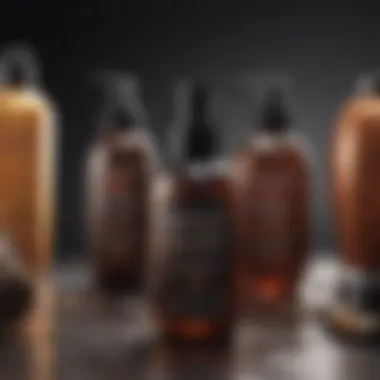Repairing Burnt Hair: Effective Solutions and Tips


Intro
Burnt hair is a common yet distressing issue that can arise from several sources, including excessive heat styling, chemical treatments, or even environmental factors. When hair sustains damage from heat, it can lose its vitality, leading to breakage, frizz, and overall poor appearance. This guide aims to explore practical methods to revive burnt hair and provide readers with an understanding of how to take preventive measures in the future. With knowledge distilled from industry experts, this article serves not just as a solution manual, but also as a resource for hair maintenance and health awareness.
Key Trends
Understanding the latest trends in hair care can significantly aid in preventing further damage to already compromised hair. Being informed about prevalent practices and products can empower individuals to make better decisions for their hair.
Overview of Current Fashion Trends
Currently, evolving fashion trends emphasize natural textures and effortless styles. This shift encourages many to minimize the use of heat styling tools like curling irons and straighteners. Instead, techniques like air drying or utilizing heat-free styling options are taking center stage. This trend reduces the risk of hair damage and promotes a more sustainable approach to beauty.
Popular Beauty Trends
In the beauty space, the application of nourishing products, such as hair masks infused with oils, is on the rise. Consumers are increasingly leaning towards products that provide moisture and strengthen hair from within. These are ideal for restoring burnt strands. Brands that emphasize natural ingredients and cruelty-free practices are gaining attention, leading to a growing awareness of sustainable beauty options.
Beauty Tips and Tutorials
When dealing with burnt hair, practical advice can make a significant difference in recovery efforts.
Step-by-Step Hair Repair Techniques
- Assess the Damage: Before proceeding with any treatment, it is important to determine how severe the damage is. Look for signs such as breakage, dryness, and frizz.
- Trim the Ends: A simple yet effective remedy is to get a trim. Removing split ends can prevent further harm and improve overall appearance.
- Deep Conditioning: Use deep conditioning treatments regularly. Look for products with ingredients like shea butter and argan oil to provide necessary nourishment.
- Avoid Heat: Steer clear of all heat styling tools until the hair has regained strength. Use protective styles during this period.
- Hydrate the Hair: Ensure that you are using leave-in conditioners or hydrating sprays that add moisture and protection.
General Hair Care Practices
- Avoid chemical processes like bleaching or dyeing until hair feels healthier.
- Incorporate mild shampoos and conditioners to prevent further dryness.
- Protect your hair from sun exposure with hats or UV sprays.
Sustainable Practices
Sustainability in beauty is an essential consideration, especially as it relates to hair care.
Understanding Sustainable Hair Care
Sustainable practices involve choosing products that are eco-friendly and free from harmful chemicals. This strategy not only benefits the user’s hair but also the environment. Look for brands that prioritize sustainability in their production processes.
Tips for Sustainable Hair Care
- Choose refillable containers when possible.
- Research brands that support fair trade and responsible sourcing.
- Identify local brands that utilize minimal packaging.
"A commitment to sustainable beauty can significantly enhance the health of both your hair and the planet, fostering a more ethical approach to personal care."
By integrating these insights and techniques, individuals can not only repair burnt hair but also cultivate a healthy hair care routine that emphasizes sustainability. Knowledge and practical steps lay the foundation for healthier, more resilient hair.
Understanding Hair Damage
Understanding hair damage is essential when dealing with burnt hair. This knowledge allows individuals to identify the causes, recognize the signs, and establish effective solutions for hair recovery. When hair sustains damage, the structure and appearance of the hair can be compromised. Often, this can lead to breakage, dullness, and an overall unhealthy look.
In this article, we will assure that you comprehend the specific factors that contribute to hair damage and the importance of immediate actions following an incident of burnt hair. Being informed equips you to make better choices regarding hair care. This will lead not only to effective repair but also to preventive strategies for the future.
What Causes Hair to Burn?
Hair burning usually results from excessive heat exposure. Common causes include:
- Hot Styling Tools: Frequent use of flat irons, curling wands, or blow dryers without proper heat protection can lead to hair damage. When high temperatures come into contact with hair, it dehydrates and weakens the strands.
- Chemical Treatments: Over-processing with dyes, bleaching agents, or relaxers can compromise the hair’s integrity. These chemicals alter the hair structure, making it more susceptible to heat damage.
- Environmental Factors: Prolonged sun exposure, chlorine from swimming pools, or high humidity can harm hair. Each of these elements dries out the hair and reduces its ability to withstand further heat exposure.
- Improper Use of Hair Products: Some products might contribute to damage when not used correctly. For example, applying excess styling gel or hairspray and then curling can lead to burnt hair.
- Mistakes During Styling: Leaving hot styling tools on the hair for too long or using them too close to the scalp can result in burns. Awareness of how to use these tools safely is vital.
Understanding these factors aids in preventing hair burns in the future.
Signs of Burnt Hair
Recognizing burnt hair is crucial for prompt action. You should be aware of the following signs:


- Dryness and Brittleness: Burnt hair lacks moisture. It feels dry and may break easily when combed.
- Split Ends: If you notice increased split ends or fraying along the hair shaft, it’s a sign of heat damage.
- Loss of Shine: Healthy hair typically reflects light. If your hair appears dull, it is often damaged and in need of care.
- Unusual Texture: Burnt hair may feel rough or stiff rather than soft.
- Change in Color: Sometimes burnt hair may change color, often taking on yellow or brassy tones, especially if bleached.
Recognizing these signs early can help prevent further damage and facilitate effective treatment.
Immediate Actions for Damaged Hair
When faced with burnt hair, taking immediate action is crucial. The sooner you address the damage, the better the chances of restoring your hair’s health. Quick intervention can prevent further damage and may even improve the overall condition of your hair. By following these steps, you can begin the recovery process effectively.
Assessing the Damage
Before taking any action, it is essential to assess the extent of the damage. Look for clear indicators such as increased dryness, brittleness, or visible breakage. Assessing the damage lets you tailor your recovery approach.
- Visual Inspection: Closely examine your hair. If it appears frizzy or has split ends, these are signs of damage.
- Touch Test: Run your fingers through your hair. If it feels rough or overly coarse, it may indicate significant damage.
Once you understand the state of your hair, you can decide on the best course of action.
Withholding Further Heat Treatments
It is important to avoid any heat styling tools while your hair is repairing. Continued use can exacerbate the damage. This includes hairdryers, straighteners, and curling irons.
- Heat-Free Styles: Consider styles that do not require heat. Braids or buns can maintain a neat appearance without added stress on the hair.
- Air Drying: Allow your hair to air dry naturally. It reduces the risk of further damage and keeps moisture intact.
Abstaining from heat is a simple yet powerful action in protecting your burnt hair.
Gentle Cleansing Techniques
Cleansing your hair requires care and gentleness when it is damaged. Using harsh shampoos can strip hair of its natural oils, worsening the situation.
- Mild Shampoos: Opt for sulfate-free shampoos. These are less harsh and more suitable for weakened hair.
- Lukewarm Water Rinse: Use lukewarm water instead of hot. Hot water can further dry out already damaged hair.
Using gentle cleansing techniques helps maintain moisture and supports healing.
Nourishing and Repairing Treatments
Addressing burnt hair effectively requires nourishing and repairing treatments. These treatments focus on restoring moisture and strengthening the hair structure that has suffered due to heat damage. By implementing these practices, you can help revitalize your hair and promote healthier hair growth in the long run.
Deep Conditioning Treatments
Deep conditioning treatments play a crucial role in nurturing damaged hair. They are designed to penetrate deeper than regular conditioners, offering intense hydration and repair. This is especially important for burnt hair, which usually lacks moisture.
Types of Deep Conditioners
Varieties of deep conditioners exist, each targeting specific needs. Some common types include protein-based and moisturizing conditioners.
- Protein-based deep conditioners are ideal for restoring strength to the hair shaft. Burnt hair often becomes weak and brittle, so protein helps to reinforce the hair structure.
- Moisturizing conditioners focus on adding hydration back into the hair. These are essential after heat damage, as burnt hair usually loses its moisture balance.
Choosing the right type depends on your hair's unique condition. A balanced approach often yields the best results.
DIY Conditioning Masks
DIY conditioning masks are not only cost-effective but also allow customization based on hair needs. People who prefer natural ingredients can create masks at home with items like avocado, honey, and coconut oil.
- The key characteristic of DIY masks is their ability to cater to individual requirements using accessible ingredients.
- They offer control over the formulation, which can adapt to the changes in hair condition. However, the effectiveness can vary widely based on individual application and hair type.
Leave-In Treatments
Leave-in treatments provide ongoing support throughout the day. Applying these products informs your hair of continuous moisture retention and protection against environmental stressors. They form a barrier, sealing in hydration and repairing damage gradually.
Benefits of Leave-In Products
Leave-in products are particularly beneficial as they are designed for prolonged exposure. The primary characteristic here is their light formulation that doesn't weigh hair down. This allows users to enjoy styling freedom while still taking care of their hair.


- They typically offer detangling benefits, which can be essential when handling damaged hair.
- Regular use may also strengthen the hair over time, leading to improved resilience against future damage.
Recommended Leave-In Conditioners
Some recommended leave-in conditioners may include products like It's a 10 Miracle Leave-In and Ouidad Moisture Lock. Each product has unique features catering to different hair types and needs.
- The availability of these products in the market makes them widely accessible.
- However, users should pay particular attention to ingredient lists, ensuring that they avoid any harmful additives that could exacerbate the problem.
Oils and Serums
Oils and serums can act as effective terminators for burnt hair. They work by providing moisture and protection, filling in gaps left in the hair cuticle after it has been damaged.
Choosing the Right Oil
Selecting the appropriate oil involves understanding your hair type. For instance, argan oil is renowned for its moisturizing properties, while coconut oil offers penetration through the hair shaft due to its structure.
- The notable aspect of choosing oils is their respective qualities. Oils not only provide nourishment but also create a protective barrier around the hair.
- Additional caution is necessary, as applying too much may lead to greasiness instead of the desired hydration.
Application Techniques
Effective application techniques ensure maximum benefit from oils and serums. A common method includes applying a small amount to towel-dried hair, focusing on the ends.
- The characteristic of proper techniques is precision in application, which prevents excess buildup in one area.
- Experimenting with different amounts and methods can offer insights into what works best, making this a collaborative journey between the individual and the product.
Care for your hair is not just about treatment; it involves understanding its needs and adapting your care routine accordingly.
Cutting Away Damage
Cutting away damaged hair is a critical step in restoring the health and appearance of burnt hair. Once hair suffers from severe heat damage, the structure of the hair is compromised. This can lead to further breakage and split ends, resulting in a lackluster look. A thoughtful trim not only helps eliminate visible damage but also promotes healthier hair growth.
The Role of a Trim
Trimming damaged hair should not be seen as a punishment, but as a beneficial action in the self-care routine. By cutting away the burned portions, you allow your hair to rejuvenate and recover. The process helps in the following ways:
- Eliminating Split Ends: When split ends are cut, the likelihood of the damage progressing up the hair shaft decreases significantly.
- Improving Manageability: Healthy hair is easier to style and maintain. A trim can make hair less prone to tangles and frizz.
- Enhancing Overall Appearance: Removing burnt hair instantly improves the visual quality, making the hair look shinier and healthier.
Choosing a Skilled Stylist
The importance of selecting a skilled stylist cannot be overstated. Not all hairdressers are familiar with the unique challenges of burnt hair. Here are some considerations when choosing the right professional:
- Experience with Damaged Hair: Look for stylists who specialize in hair restoration or have significant experience in dealing with damaged hair. Ask them about their previous work and concepts of hair health.
- Consultation: A good stylist should offer an initial consultation. They should assess the damage and give informed suggestions on the best course of action.
- Reviews and Recommendations: Seek testimonials from previous clients. Social media platforms and websites such as Reddit can provide valuable feedback.
- Techniques Used: Inquire about the techniques employed for trimming. A stylist should know how to trim without making the damage worse, ensuring you leave with healthier hair.
"Investing time in the right stylist can lead to significant improvements in hair health over time."
Choosing wisely can help create a path towards recovery and ensure that future hair management is a lot easier.
Preventive Measures for Future Hair Health
Preventing further damage to burnt hair is essential for long-term health and resilience. Understanding how to protect hair from future harm can save time and resources in the recovery process. Preventive measures help maintain the structural integrity of the hair, reducing the need for excessive treatments and the associated costs related to repair. Moreover, these practices contribute to overall hair vitality, ensuring that it remains strong and beautiful.
Heat Protection Practices
Heat is one of the primary culprits contributing to hair damage. Therefore, adopting heat protection practices is crucial. Using heat protectant sprays or serums before styling can significantly reduce thermal exposure. These products form a barrier on the hair shaft, minimizing moisture loss and preventing cuticle damage. Chose a protectant that suits your hair type. Look for ingredients such as silicones or oils to create this protective layer. Regularly incorporating these protectants can greatly extend the longevity of your styles while safeguarding your hair.
Avoiding Chemical Treatments
Chemical treatments, such as bleaches and relaxers, can be harsh on already vulnerable hair. Avoiding these processes helps protect the hair's natural structure and moisture balance. Instead of chemical treatments, consider more natural alternatives for altering color or texture. Natural dyes or botanical extracts can provide color without compromising the hair's health. Steering clear of chemical treatments allows the hair to recover, paving the way for growth and strength.
Healthy Hair Care Routine
Establishing a healthy hair care routine is a key factor in preventing further damage.


Choosing the Right Products
Choosing the right products is essential for maintaining hair health. This means selecting shampoos, conditioners, and styling products that cater specifically to your hair’s needs. Look for sulfate-free shampoos that cleanse without stripping natural oils. Conditioners should be packed with hydrating ingredients like coconut oil or shea butter. These characteristics make such products a beneficial choice. The right products can restore moisture balance, addressing dryness and fragility. Always read labels to understand the ingredient lists and opt for products that prioritize nourishment without harmful additives.
Regular Maintenance
Regular maintenance of your hair also plays a pivotal role in its long-term health. This includes regular trims to eliminate split ends and prevent further breaking. Establish a schedule for visits to your stylist. It is often recommended to cut the ends every six to eight weeks for optimal hair health. Regular maintenance ensures that any damage is addressed before it can worsen, keeping the hair looking fresh and manageable. Consistency in care will lead to visible improvements over time.
Consulting Professionals
Understanding when to consult a professional is crucial for effective hair care, especially when dealing with burnt hair. Consulting a professional not only accelerates the recovery process but also ensures that you receive tailored treatments that align with your specific hair needs. Unlike at-home solutions, professionals have the expertise to assess the extent of damage and recommend the right interventions that you might overlook.
When to Seek Help
It is important to recognize the signs indicating a need for professional consultation.
- Severity of Damage: If the hair feels excessively brittle, dry, or if there are visible split ends, it's time to seek help. Professionals can discern deeper issues that might not be evident at first glance.
- Ineffective Home Treatments: If your attempts to repair your hair using DIY methods are not yielding results, a professional can provide more potent remedies.
- Health Concerns: If burnt hair is accompanied by scalp issues, such as redness, irritation, or pain, it is essential to consult a dermatologist.
Potential Treatments Available
Several treatment options are available through professional services. These can broadly be categorized into salon treatments and medical options, each with unique advantages and drawbacks.
Salon Treatments
Salon treatments often focus on hydration, strengthening, and immediate repair. A key characteristic of salon treatments is their accessibility and specialized formulations. Many salons offer customized solutions known for addressing specific damage types. Keratin treatments are a prime example, providing a smoothing effect and reducing frizz.
The unique feature of salon treatments is their ability to utilize professional-grade products and techniques that are not typically available for home use. Benefits include:
- Immediate Results: Many treatments can restore hair’s appearance almost instantly, making it a good choice for events or special occasions.
- Expertise: Experienced stylists can tailor treatments to individual hair types and damage levels, offering a degree of personalization.
However, some disadvantages include cost and potential chemical exposure. Treatments can be pricey, and not all options will suit every hair type.
Medical Options
Medical options often come into play when damage has lead to more severe health issues. Dermatologists can offer solutions that are medically sound and suitable for those experiencing significant hair loss or scalp conditions caused by burning.
A notable characteristic of medical options is their scientific approach, addressing underlying issues rather than superficial symptoms. Pharmaceutical treatments and scalp therapies are examples of this avenue. Advantages include:
- Scientific Backing: Medical treatments are usually supported by research and tailored recommendations.
- Comprehensive Care: Hair health is often linked with overall health, and addressing underlying conditions can improve hair quality.
The downside may be that medical options are not always straightforward or quick. They can require a more extended commitment, needing multiple appointments or ongoing treatments.
"Consulting a professional is not an admission of defeat; rather, it’s a strategic step towards restoring your hair’s health and vitality."
Overall, whether considering salon or medical options, consulting professionals provides essential support for anyone dealing with burnt hair, ensuring a healthier future for your locks.
Long-Term Care and Maintenance
Long-term care and maintenance are crucial for restoring and preserving the health of burnt hair. After addressing immediate issues and applying nourishing treatments, it is essential to maintain a consistent hair care routine. This ensures that the hair continues to recover and remains resilient against future damage. Proper long-term care can help individuals see lasting results, ultimately leading to healthier hair overall.
Nutritional Support for Hair
Essential Vitamins and Minerals
Essential vitamins and minerals play an integral role in hair health. These nutrients are pivotal for the growth and repair of hair tissue. Key vitamins, like biotin, support the formation of keratin, which is vital for hair structure. Iron, on the other hand, is crucial as it helps in carrying oxygen to hair follicles, aiding in their growth.
The unique feature of these nutrients is their ability to address deficiencies that can lead to hair loss. Many people overlook dietary habits, but nutrition directly impacts hair. Focusing on a balanced intake of vitamins and minerals can significantly improve hair condition over time. However, relying solely on supplements may not be the most effective approach. It is vital to ensure these nutrients are obtained naturally through food for the best results in this article.
Dietary Recommendations
Dietary recommendations form the backbone of a holistic approach to hair care. Consuming a well-rounded diet rich in fruits, vegetables, lean proteins, and healthy fats can support hair recovery and longevity. Foods high in omega-3 fatty acids, such as salmon and walnuts, offer anti-inflammatory properties that promote scalp health. Meanwhile, leafy greens provide essential vitamins like A and C, contributing to natural sebum production.
The key characteristic of these recommendations is their comprehensive nature. Instead of focusing solely on hair products, encouraging overall nutrition addresses the root causes of hair damage. People often find this approach beneficial as it not only aids in hair health but also supports overall well-being. While it may take time to see improvements in hair texture, the gradual changes in diet lead to sustainable results.
Routine Hair Checks
Routine hair checks are important in maintaining the quality of hair. Regularly examining the health of your hair can help detect early signs of damage. This proactive approach allows individuals to address specific issues before they escalate. Observing changes in texture, look, or scalp health can provide valuable insights into the effects of environmental factors, products, or diet.



